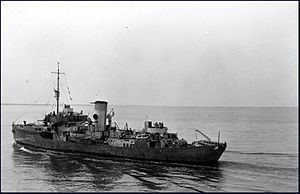Name Moncton Ordered 24 January 1940 Commissioned 24 April 1942 Launched 11 August 1941 | Laid down 17 December 1940 Construction started 17 December 1940 Draft 3.51 m | |
 | ||
Decommissioned paid off 12 December 1945 | ||
HMCS Moncton was a Flower-class corvette that served in the Royal Canadian Navy during the Second World War. She served on both coasts of Canada. She is named after Moncton, New Brunswick.
Contents
Background
Flower-class corvettes like Moncton serving with the Royal Canadian Navy (RCN) during the Second World War were different from earlier and more traditional sail-driven corvettes. The "corvette" designation was created by the French as a class of small warships; the Royal Navy borrowed the term for a period but discontinued its use in 1877. During the hurried preparations for war in the late 1930s, Winston Churchill reactivated the corvette class, needing a name for smaller ships used in an escort capacity, in this case based on a whaling ship design. The generic name "flower" was used to designate the class of these ships, which – in the Royal Navy – were named after flowering plants.
Corvettes commissioned by the Royal Canadian Navy during the Second World War were named after communities for the most part, to better represent the people who took part in building them. This idea was put forth by Admiral Percy W. Nelles. Sponsors were commonly associated with the community for which the ship was named. Royal Navy corvettes were designed as open sea escorts, while Canadian corvettes were developed for coastal auxiliary roles which was exemplified by their minesweeping gear. Eventually the Canadian corvettes would be modified to allow them to perform better on the open seas.
Construction
She was ordered on 24 January 1940 as part of the 1939-1940 Flower-class building program. She was laid down bym St. John Dry Dock & Shipbuilding Co. Ltd. at Saint John on 17 December 1940 and was launched on 11 August 1941. She commissioned into the RCN on 24 April 1942 at Saint John. Moncton was the last of the RCN's original 64 Flower-class orders to be completed and her construction had been significantly delayed due to heavy demands on her builder for priority repair work on war-damaged ships.
Wartime service
Following her commissioning, Moncton sailed to Halifax and was assigned to Atlantic Coast Command (AT) but unallocated as she was fitting out and performing sea trials for the remainder of April. In May she began work-ups with her new crew out of Halifax and she joined the RCN's Atlantic Fleet on 12 May 1942. Another highlight for Moncton in 1942 was conducting training with (an as yet anonymous) British submarine off Halifax.
From June 1942 to June 1943, Moncton was tasked to Western Local Escort Force (WLEF) for convoy escort operations. In June 1943, WLEF was divided into separate escort groups and Moncton was tasked to EG W5 (HQ in Halifax) during June–July. Moncton collided with merchant Jamaica Producer on 28 July 1943. From August–September 1943 Moncton underwent repairs at Dartmouth Marine Slips, Dartmouth. She returned to EG W5 and operated in convoy escort operations from October–December.
Moncton was transferred to the RCN's Pacific Fleet in January 1944 and departed for Esquimalt, via Guantanamo Bay, Cristóbal, Balboa and San Pedro. Upon her arrival, she was tasked to the Esquimalt Force (unallocated) and underwent an extensive refit at Vancouver from 5 May - 7 July 1944 where her forecastle was extended and she was brought into line with the modified Flower-class design. From July 1944 to December 1945 she was tasked to Pacific Coast Command (unallocated).
Following V-J Day, she was placed in reserve status at Esquimalt and decommissioned from the RCN on 12 December 1945, the last of the first batch of Flower class corvettes to serve the Navy as an active warship.
Convoy list
This is a list of the convoys that Moncton escorted:
The information for the convoys was obtained from two of the links below:
www.convoyweb.org.uk/ and www.warsailors.com
Commanding officers
Moncton had 6 commanding officers during her service in the RCN:
Civilian service
Moncton was sold by Crown Assets in 1955 into mercantile service and was re-flagged under the Netherlands as the whaling ship Willem Vinke, 718 GRT. She was scrapped September in 1966 at Santander, Cantabria, Spain by Recuparciones Submarinas S.A.
